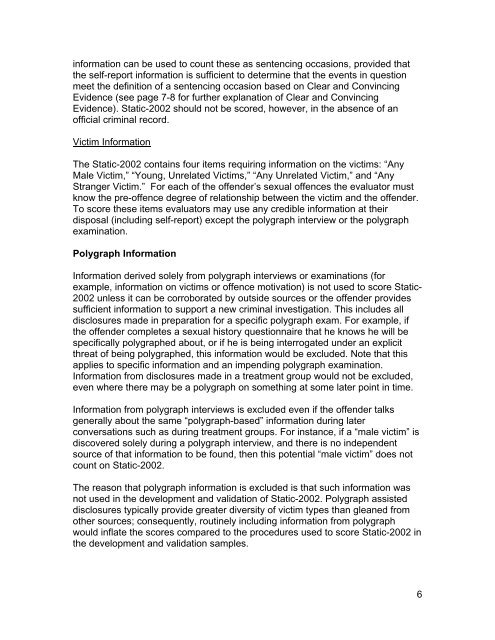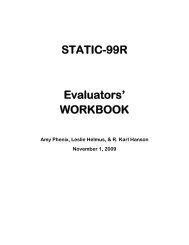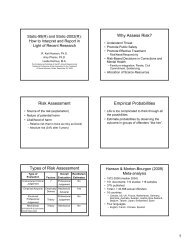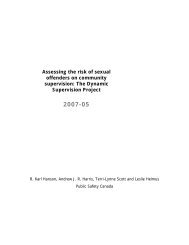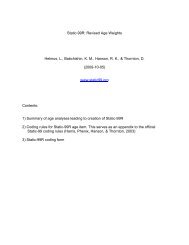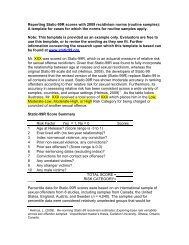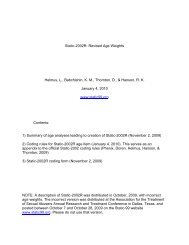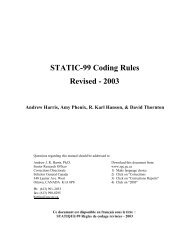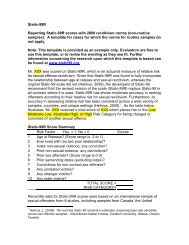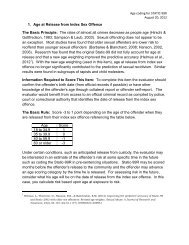Static-2002 coding rules (2009) - Static-99
Static-2002 coding rules (2009) - Static-99
Static-2002 coding rules (2009) - Static-99
Create successful ePaper yourself
Turn your PDF publications into a flip-book with our unique Google optimized e-Paper software.
information can be used to count these as sentencing occasions, provided that<br />
the self-report information is sufficient to determine that the events in question<br />
meet the definition of a sentencing occasion based on Clear and Convincing<br />
Evidence (see page 7-8 for further explanation of Clear and Convincing<br />
Evidence). <strong>Static</strong>-<strong>2002</strong> should not be scored, however, in the absence of an<br />
official criminal record.<br />
Victim Information<br />
The <strong>Static</strong>-<strong>2002</strong> contains four items requiring information on the victims: “Any<br />
Male Victim,” “Young, Unrelated Victims,” “Any Unrelated Victim,” and “Any<br />
Stranger Victim.” For each of the offender’s sexual offences the evaluator must<br />
know the pre-offence degree of relationship between the victim and the offender.<br />
To score these items evaluators may use any credible information at their<br />
disposal (including self-report) except the polygraph interview or the polygraph<br />
examination.<br />
Polygraph Information<br />
Information derived solely from polygraph interviews or examinations (for<br />
example, information on victims or offence motivation) is not used to score <strong>Static</strong>-<br />
<strong>2002</strong> unless it can be corroborated by outside sources or the offender provides<br />
sufficient information to support a new criminal investigation. This includes all<br />
disclosures made in preparation for a specific polygraph exam. For example, if<br />
the offender completes a sexual history questionnaire that he knows he will be<br />
specifically polygraphed about, or if he is being interrogated under an explicit<br />
threat of being polygraphed, this information would be excluded. Note that this<br />
applies to specific information and an impending polygraph examination.<br />
Information from disclosures made in a treatment group would not be excluded,<br />
even where there may be a polygraph on something at some later point in time.<br />
Information from polygraph interviews is excluded even if the offender talks<br />
generally about the same “polygraph-based” information during later<br />
conversations such as during treatment groups. For instance, if a “male victim” is<br />
discovered solely during a polygraph interview, and there is no independent<br />
source of that information to be found, then this potential “male victim” does not<br />
count on <strong>Static</strong>-<strong>2002</strong>.<br />
The reason that polygraph information is excluded is that such information was<br />
not used in the development and validation of <strong>Static</strong>-<strong>2002</strong>. Polygraph assisted<br />
disclosures typically provide greater diversity of victim types than gleaned from<br />
other sources; consequently, routinely including information from polygraph<br />
would inflate the scores compared to the procedures used to score <strong>Static</strong>-<strong>2002</strong> in<br />
the development and validation samples.<br />
6


